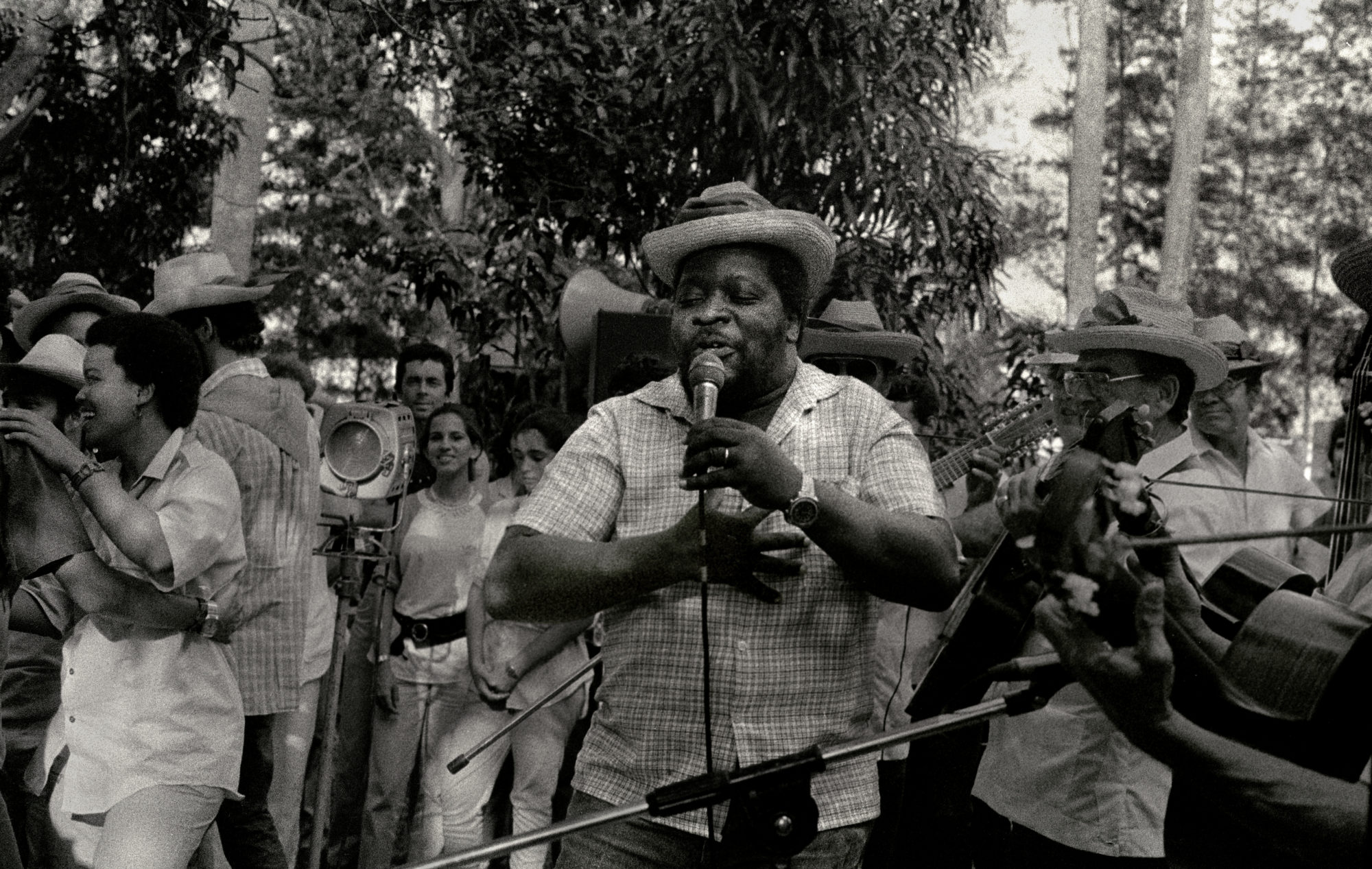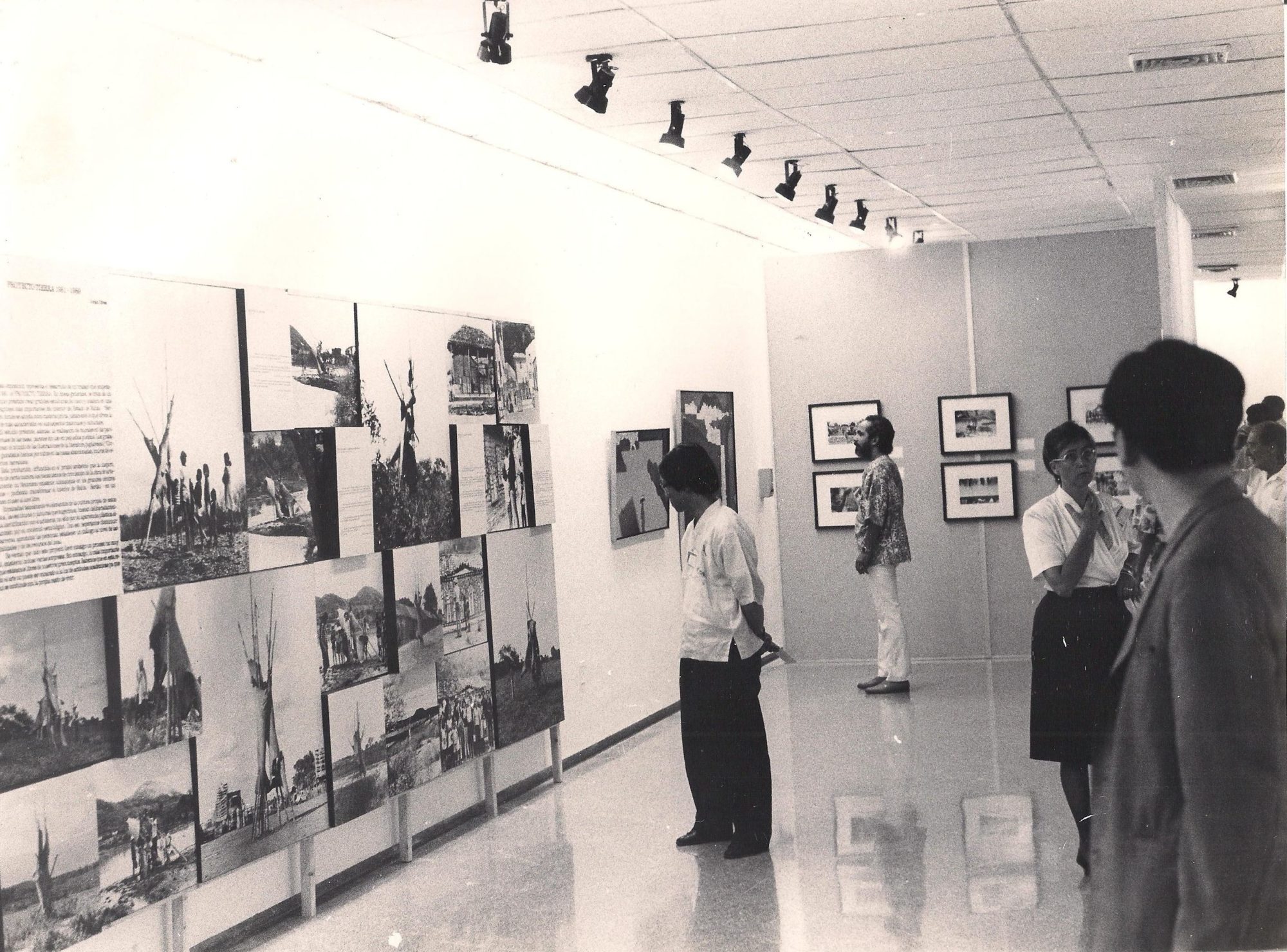Artivism and the Havana Biennial – an Interview with Gerardo Mosquera
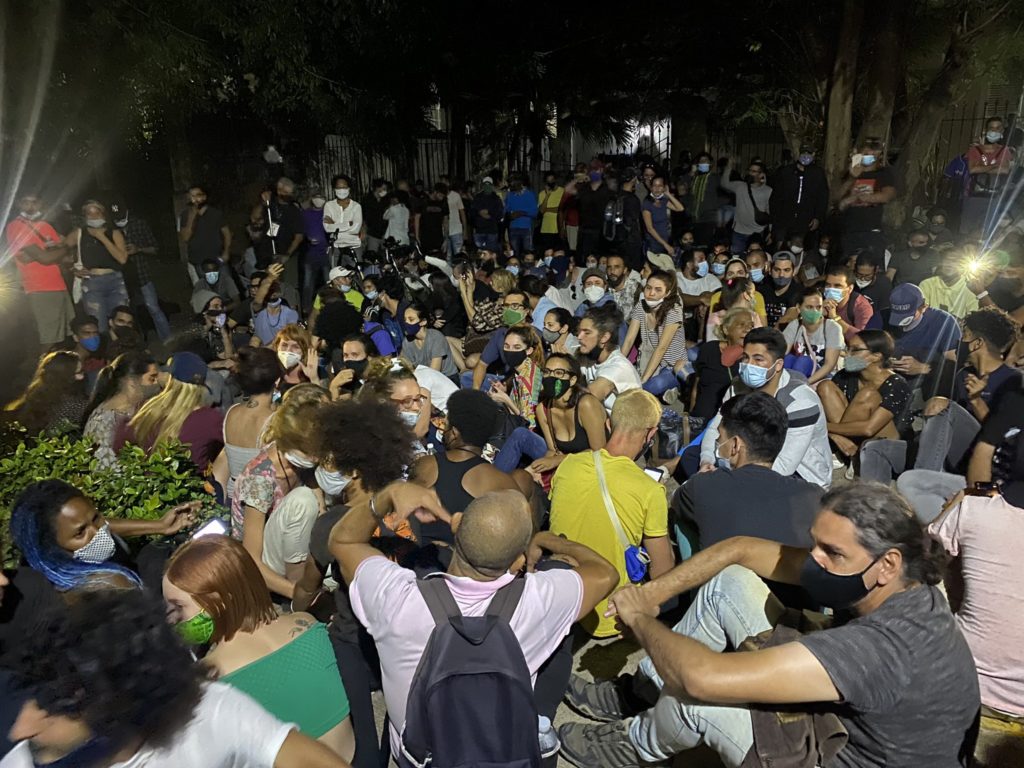
Protest on November 27, 2020, which saw hundreds of Cuban artists and intellectuals gathering outside the Ministry of Culture for over twelve hours to demand a meeting with officials. It lead to the formation of the 27N movement.
Image: Luz Escobar
Gigi Argyropoulou: Let’s start with a quick overview of the cultural scene in Cuba and how it has developed in recent decades. How is the cultural landscape organized structurally and artistically? How do institutions, funding bodies and independent initiatives interrelate? Do you see specific tendencies or political discourses reflected in emergent art practices?
Gerardo Mosquera: Cuba is an extremely centralized, totalitarian country, which continues to follow an institutional Stalinist model. Civil society was almost destroyed in the late 1960s, when all private economic activity was confiscated and forbidden, including jobs carried out by individuals, as plumbers or cobblers. Something similar happened to private organizations, which were also dismantled or submitted to strict control. Museums, art centers, art schools, houses of culture, and art organizations are state owned and run. Only in recent years some private galleries have been allowed, under a turn-a-blind-eye policy. The Havana Biennial and other art events are also run by official institutions that report to the Ministry of Culture.
This centralized system has been tolerant or repressive according to the times and to the pressure exercised by artists, curators and critics. A canonic style as socialist realism was never imposed, but in the 1970s, ideological norms were compelled to the arts, and many intellectuals were marginalized. In the 1980s, the so called New Cuban Art broke this situation, transforming forever the conservative official cultural policy that had prevailed during that decade, pushing the Ministry of Culture towards a more liberal policy.[1] The young artists developed a free, contemporary, internationally open approach to art, and initiated a critical orientation that was allowed to a certain extent, although many censorship cases happened. From the visual arts a critical culture expanded to all of the arts and to literature, deconstructing official rhetoric and representations, analyzing the reality of the Cuban Revolution’s failed utopian project. This laid the foundations of the extraordinary events that we are witnessing today, when we see artists and intellectuals leading the awakening of civil society and the political opposition to the regime. Tania Bruguera played and continues to play an immense role in this process.
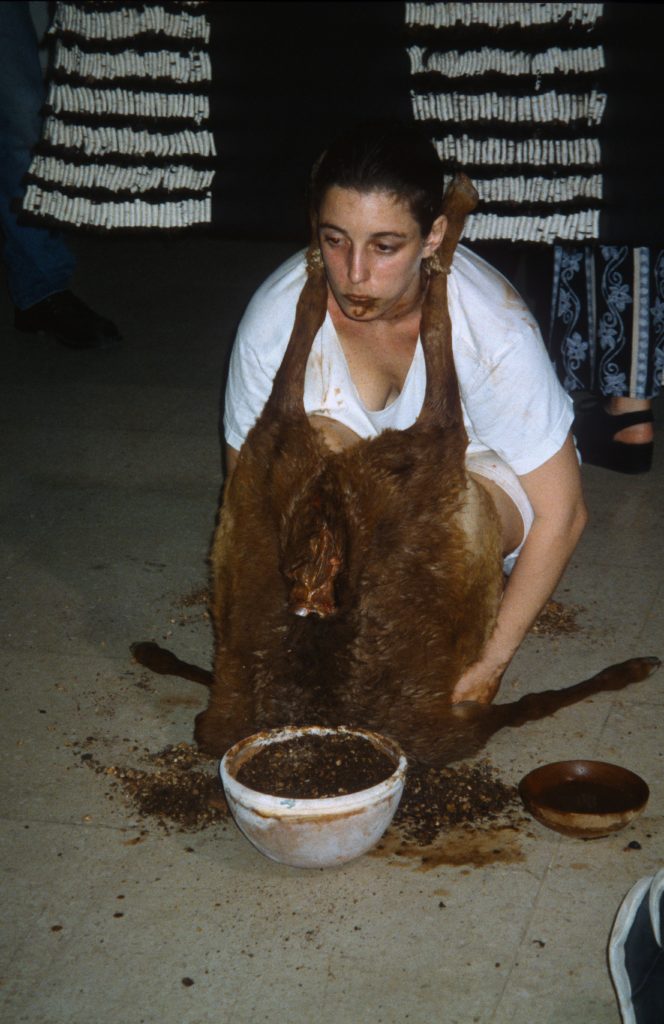
Tania Bruguera at a performance at the Havana Biennial 1997.
Images: Gerhard Haupt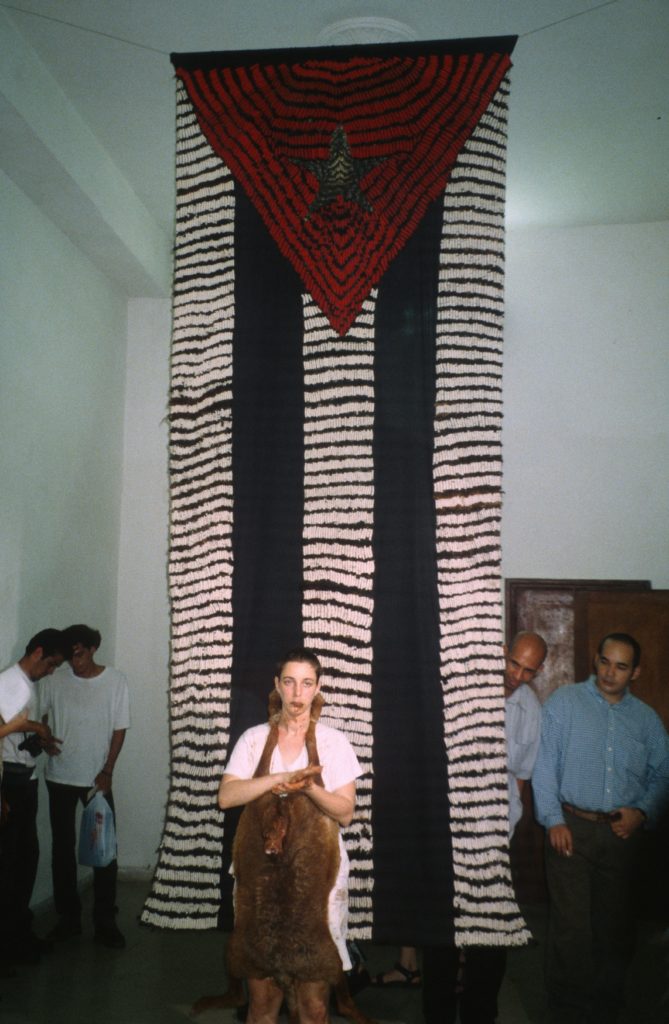
In 1994, two young artists founded at their home in Havana Espacio Aglutinador an independent art space that managed to weather official hostility and survived until today, presenting a very important and diverse program. Other independent spaces followed, but had short lives. In many cases artists also use their studios as personal galleries. The State aims to control the art scene as much as possible, but it has to be flexible in front of the intense independent activity that has boomed. There is a permanent pulse between the state and art practitioners. Nowadays many independent artivist organizations, as Movimiento San Isidro, Colectivo 27N, and Instituto de Artivismo Hannah Arendt are giving the tone of the situation.
Gigi Argyropoulou: Let’s go back to the initiation of the first biennial of Cuba back in 1984. Why the term “biennial” and what did it attempt to achieve within the specific socio-political context of Cuba and globally at that moment in time? What changes do you think did it bring at a structural level (cultural policies) and also in the local art scene (cultural production)?
Gerardo Mosquera: The Biennial was born in the utopian context of the Cuban Revolution out of the will of transforming international power relations on art circulation and legitimation. It was part of Cuba’s strategy of organizing every kind of international event in all fields as a way of publicizing its messianic political goals and building a good image. Representation and self-branding have always been a priority for the Cuban regime that has surpassed the country’s scale and economic situation – its intense expenditure in cultural activity has always been ideological, with a strong international side.
However, we would restrict our view on this policy if we were to merely think that its purposes was only to promote socialist ideas, to fight against Cuba’s isolation imposed by the USA, to showcase a good image of the country, and to co-opt artists and intellectuals. Cuba had a genuine Latin American and Third World cultural and political agenda that was sometimes at odds with the Soviet Union’s communist orthodoxy. And as part of the role of a beachhead for USSR policy that Cuba used to play, the island’s peculiar character – its culture, history, and geographic location was unique within the Soviet block – was instrumentalized those days to try to sustain Cuba as a Third World leader. Therefore, on the one hand, for historical, political and cultural reasons, Cuba had a true inclination towards Caribbean, Latin American and postcolonial cultures in general. On the other, this inclination was exploited and supported by the USSR to gain political influence over Third World countries.
The Biennial was a paradoxical good fruit of the Cold War. It was conceived as an open space for contemporary artists, critics, curators, and scholars from Africa, Asia, the Caribbean, Latin America, and the Middle East, including their diasporas, to meet and become acquainted with each other’s work and ideas beyond ideology or sheer politics. The Biennial created a platform for research and promotion at a time when artists from the “peripheries” (most of the world) were unknown beyond their local contexts.
The opening of a “horizontal”, “South to South” space of encounter and discussion for artists, critics and curators from all over the world who were segregated to local or regional ghettos was a very operative function achieved by the Biennial. Of course, by creating this much needed space, the Cuban regime was successfully contributing to fulfill its geopolitical goals, but at the same time it was satisfying a critical need for contemporary art outside the mainstream.
It is crucial to take into account that the Biennial was born in the context of a radical cultural renovation that was being carried out in Cuba by a new generation of visual artists, the aforementioned New Cuban Art. These artists and critics transformed forever the conservative official cultural policy that had prevailed during that decade. The young artists developed a contemporary, postmodern, internationally open approach to art, creating a new climate that was crucial to shape the Biennial’s nature and to provide a vivacious environment for it. At the same time, the Biennial showcased these artists internationally.
In Cuba, the Biennial created an international network for the artists. Visiting curators and museum directors became acquainted with contemporary Cuban art and invited artists to be part of exhibitions, to artists’ residencies abroad, to conferences, etc. Visiting collectors – especially US ones – bought local artwork to an unprecedented scale. The Biennial also acted as an umbrella under which an unofficial, independent and spontaneous program bloomed under Cuban artists’ and curators’ initiatives. The Biennial contributed in creating a more open and dynamic climate in Cuba’s art scene and to internationalize it.
Gigi Argyropoulou: Can you talk to us about your concept of “Museum as a hub”. Did such ideas emerged from your experience in the Cuban art scene and to what degree do you see them applicable in other contexts?
Gerardo Mosquera: The “museum-as-hub” is a rather utopian idea that has nothing to do with Cuba. It came from my working around the globe and witnessing the upsurge of lively contemporary art practices throughout the planet, frequently amidst difficult situations. This emergence not only includes the creation of strong and plausible art, but also the foundation of artists groups, alternative spaces, and irregular organizational forms for art at the base. These forms of self-organization suffer from a lack of infrastructure, which on the one hand has stimulated a sort of lively informal economy of art, but on the other also lead to the emigration of artists, especially from African countries.
If museums want to respond to the challenges of contemporary art’s escalating international production and circulation, they will have to confront their own conservative nature. Museums began as collections that were shown publicly and permanently. Then their space acquired importance beyond collections, as a site where exhibitions and events took place. Perhaps today’s situation points to a third major shift in museum’s practice, one that will take it away from the prevalent collection-centered and space-centered routines to a more dynamic endeavor, in which the museum will be a moving activity spread over the globe. Such rhyzomatic museum-as-hub practices will entail a decentralized institution that will conceive, curate, and/or participate simultaneously in a wide range of diverse projects, mainly collaborations and joint ventures, at the very spot where art practices take place, and with very flexible levels of involvement. My vision was to transform the New Museum of Contemporary Art Education Department into a program that was called Museum as Hub, which partially put these ideas in practice over several years.
A problem with such a perspective is that it could mean a qualitative new intrusion of hegemonic institutions in art activities in their own contexts, which could be patronizing and imposing. Indeed, ambivalence is implicit, but a decentralized system, in which local museums and institutions will have a chief role, could also work the other way around. It could enhance and expand the initiative and action of new artistic subjects in their contexts, where they often work in precarious conditions, by taking advantage of financial and moral support and of facilities that the network could provide. And these subjects are not passive: their agency could contribute to disrupt the museum’s centered control.
Gigi Argyropoulou: Finally let’s move into the present in Cuba. Can you talk to us about the current situation in Cuba? How the art scene responds at this moment in time? And also how do you see the role of large-scale art institutions in this context?
Gerardo Mosquera: As I mentioned before, something extraordinary is taking place in Cuba: artists, curators, writers, musicians, filmmakers… are leading the political opposition to the regime today. Their actions range from artivism to political demonstrations, as when hundreds of them congregated in front of the Ministry of Culture in Havana a year ago demanding freedom of speech but also civil rights and political change. The 27N collective was born as a result of this event. Together with the San Isidro Movement they have been on the front line criticizing the government on social media and in demonstrations. Social media has become a space where intellectuals keep reacting to and denouncing social problems in Cuba. Yunior García, a playwright and actor, recently organized Archipiélago, an online platform of thousands of persons that summoned a peaceful march that was impeded by strong police control and repression.
Cultural institutions have been reluctant to undertake dialogue, as cultural practitioners have demanded. On the contrary, they became one with the State Security, repressing them. Many artists and intellectuals have been harassed, menaced, detained, interrogated, expatriated, and put in jail without due legal process, just for their peaceful demands for freedom and for change in the country. Tania Bruguera has suffered and endured this violence. Strong solidarity has flourished among Cuban intellectuals both on the island and in the Cuban diaspora, going beyond the intellectual field; marches and demonstrations supporting change in Cuba have taken place in dozens of cities around the world. Solidarity has been expressed also by important figures from other countries, all of which stood against intolerance and repression in Cuba.
Gigi Argyropoulou: This leads to the question of solidarity from the international left. Is this something Cubans artists feel is lacking because of the government claiming the leftist legacy?
Gerardo Mosquera: The situation has changed and many on the left have awakoned out of their blind, religious faith in the myth of the Cuban Revolution and are expressing their solidarity to fellow intellectuals and people in Cuba.
[1] Gerardo Mosquera, “The New Cuban Art”, in: Ales Erjavec (editor): Postmodernism and the Post Socialist Condition. Politicized Art under Late Socialism, Los Angeles/Berkeley/London, University of California Press, 2003, ps. 208-246.
